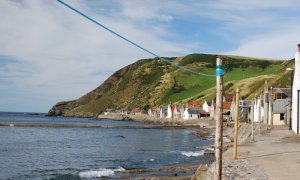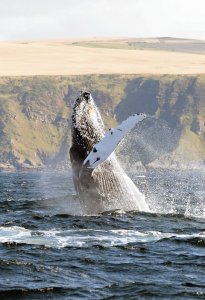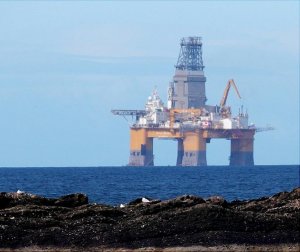Capt Lightning
Well-known Member
- Location
- Historic Buchan, Scotland
Crovie (pronounced Crivvy)
Tired of living in the city with all that traffic, noise and crowds? Need a break?
Pass me that hoilday brochure please. Hey, this sounds good.. "Traditional fisherman's cottage in quiet village with uninterrupted sea views". Sounds great.
Crofting has a specific legal definition in Scotland. Basically a croft would consist of a rented cottage on
a plot of ground for growing vegetables, crops etc.. and the right to craze livestock on common land.
This was a hard life for the crofting family - not only surviving the harsh conditions, but also paying the
rent to the landlord. What happened in the 18th & 19th centuries is still the subject of passionate debate and
anger amongst the (primarily Highland) people. Landlords realised that sheep were much more profitable than
poor tennant farmers, and so began what is commonly known as the 'Highland clearances'. Some landlords
were particularly brutal, evicting whole communities, burning and flattening their crofts to make way for sheep.
Crovie as it is today. Note the clothes lines to dry the washing. All mod-cons here!

The village of Crovie as it stands today was established by families cleared from inland estates in the late
eighteenth century, although a small settlement had already existed there for several hundred years.
Having been moved off their land to make way for their landlord's sheep, they then had the 'pleasure' of
fishing for the landlord, largely for his benefit but entirely at their risk.
By the mid nineteenth century some fishermen had built their own boats, and by the end of the century
some fifty such boats sailed from Crovie.
The first half of the twentieth century saw a gradual decline in Crovie's fishing fleet with the development of
larger vessels too big for Crovie's small harbour. However, fishing and almost Crovie itself,
came to an abrupt end on 31 January 1953.
A storm that had been building since the previous night became a hurricane and huge seas battered the village.
The path to the neighbouring village was washed away together with Crovie's sea defences and a number of houses.
The village ceased to be viable almost immediately, and many residents simply abandoned it,
moving round the bay to Gardenstown. The remaining cottages were sold for as little as £50 (about $75 US).
A windy day - taken further alon the coast, this is a view lookin towards Crovie..

The council wanted to knock down the remaining cottages and move the remaining residents to new housing, but
a few people wanted to preserve the village and restoration began. Today, Crovie is a 'conservation area' and
regarded as one of Europe's best preserved fishing villages with a permenant population of 6. It is fairly unique
in that there are no roads. There is so little space in front of the houses, there is only room for a footpath.
In a small parking place at the Western end of the village, there are a number of handcarts. The residents and visitors use these to transport their belongings to the cottages whose addresses are 1 Crovie, 2 Crovie, 3 Crovie etc.....
The path to Gardenstown has been walk by many people includin Prince Charles and Malcolm McLaren (the late manager of the 'Sex Pistols')

The majority of the well restored dwellings are now holiday cottages. Crovie is a popular vacation spot, offering a total contrast to town or city living. It's quite surprizing to find people from all over Europe staying there.
I wonder how they ever found out about this tiny village. Those who do find it will have to walk along a narrow coastal path to the next village to shop, or drive the 10 miles to Banff to find larger stores, but it is well worth finding.
I wish I had taken this picture! A Humpback whale seen off Crovie...

This is one I did take fron Crovie - an oil drilling rig is towed slowly out into the North sea

Tired of living in the city with all that traffic, noise and crowds? Need a break?
Pass me that hoilday brochure please. Hey, this sounds good.. "Traditional fisherman's cottage in quiet village with uninterrupted sea views". Sounds great.
Crofting has a specific legal definition in Scotland. Basically a croft would consist of a rented cottage on
a plot of ground for growing vegetables, crops etc.. and the right to craze livestock on common land.
This was a hard life for the crofting family - not only surviving the harsh conditions, but also paying the
rent to the landlord. What happened in the 18th & 19th centuries is still the subject of passionate debate and
anger amongst the (primarily Highland) people. Landlords realised that sheep were much more profitable than
poor tennant farmers, and so began what is commonly known as the 'Highland clearances'. Some landlords
were particularly brutal, evicting whole communities, burning and flattening their crofts to make way for sheep.
Crovie as it is today. Note the clothes lines to dry the washing. All mod-cons here!

The village of Crovie as it stands today was established by families cleared from inland estates in the late
eighteenth century, although a small settlement had already existed there for several hundred years.
Having been moved off their land to make way for their landlord's sheep, they then had the 'pleasure' of
fishing for the landlord, largely for his benefit but entirely at their risk.
By the mid nineteenth century some fishermen had built their own boats, and by the end of the century
some fifty such boats sailed from Crovie.
The first half of the twentieth century saw a gradual decline in Crovie's fishing fleet with the development of
larger vessels too big for Crovie's small harbour. However, fishing and almost Crovie itself,
came to an abrupt end on 31 January 1953.
A storm that had been building since the previous night became a hurricane and huge seas battered the village.
The path to the neighbouring village was washed away together with Crovie's sea defences and a number of houses.
The village ceased to be viable almost immediately, and many residents simply abandoned it,
moving round the bay to Gardenstown. The remaining cottages were sold for as little as £50 (about $75 US).
A windy day - taken further alon the coast, this is a view lookin towards Crovie..

The council wanted to knock down the remaining cottages and move the remaining residents to new housing, but
a few people wanted to preserve the village and restoration began. Today, Crovie is a 'conservation area' and
regarded as one of Europe's best preserved fishing villages with a permenant population of 6. It is fairly unique
in that there are no roads. There is so little space in front of the houses, there is only room for a footpath.
In a small parking place at the Western end of the village, there are a number of handcarts. The residents and visitors use these to transport their belongings to the cottages whose addresses are 1 Crovie, 2 Crovie, 3 Crovie etc.....
The path to Gardenstown has been walk by many people includin Prince Charles and Malcolm McLaren (the late manager of the 'Sex Pistols')

The majority of the well restored dwellings are now holiday cottages. Crovie is a popular vacation spot, offering a total contrast to town or city living. It's quite surprizing to find people from all over Europe staying there.
I wonder how they ever found out about this tiny village. Those who do find it will have to walk along a narrow coastal path to the next village to shop, or drive the 10 miles to Banff to find larger stores, but it is well worth finding.
I wish I had taken this picture! A Humpback whale seen off Crovie...

This is one I did take fron Crovie - an oil drilling rig is towed slowly out into the North sea


